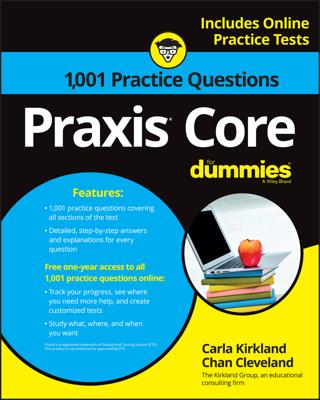Before taking the Praxis, do as many practice exams and sample questions as you can. This will help make you more prepared and make you more confident on test day.
Sample Questions
Directions: The following passage is a draft of an essay. Some portions of the passage need to be strengthened through editing and revision. Read the passage and choose the best answers for the questions that follow. choosing answers, consider development, organization, word choice, style, and tone, and follow the requirements of standard written English. Remember, try to answer every question.
1 One of the traditional aspects of successful art is that people take it for real. 2 Pliny describes a famous painting competition between Zeuxis and Parrhasius in the fifth century BCE. 3 Zeuxis unveiled his painting of a still life in which the grapes were so tempting that a bird came to peck at them.
4 Zeuxis then asked Parrhasius to draw the curtain to reveal his painting. 5 Parrhasius explained that the curtain was itself a painting.
6 When Sir Thomas More’s Utopia was published in the 16th century, a priest asked his bishop to send him to Utopia (Utopia is a fictional island — its name in Greek means ‘‘no place’’ — but the characters in the book share their names with real people and so perhaps are real, and one describes his visit to Utopia).
7 On his deathbed Balzac called for Dr. Bianchon, being one of his fictional creations. 8 Before Freud had a sizable body of patients on which to base case studies, he turned to realist drama — Shakespeare, Ibsen, Greek tragedy — to analyze its characters. 9 It may sound odd to talk of Greek drama with its masks and formal choruses as ‘‘realistic,’’ but Freud was responding to the plays’ emotional realism.
10 “Lifelike’’ and ‘‘realistic’’ are always compliments, the barometers by which we judge how (or whether) a performance has worked. 11 But increasing numbers of literary critics are questioning whether this should be so. 12 In the U.K. of the 1950s, the queen’s Christmas Day broadcasts undoubtedly seemed lifelike to viewers, but in 2012 they seem stilted, not at all related to anything we recognize as natural.
13 As Edward Pechter points out, questions about what is lifelike in Renaissance drama confuse means and effects. 14 The actor Thomas Betterton ‘‘may have chanted — that is, have sounded like chanting to us if we were able to travel back in time to the Theatre Royal in the late 17th century — but to his audience, tuned to a different frequency, his performance might have seemed like life itself.’’
Which word would be the best replacement for aspects as it is used in Sentence 1 (reproduced below)?
One of the traditional aspects of successful art is that people take it for real.
(A) prizes
(B) hallmarks
(C) aspirations
(D) pitfalls
(E) emanations
Which is the best way to revise and combine Sentences 4 and 5 (reproduced below) at the underlined portion?
Zeuxis then asked Parrhasius to draw the curtain to reveal his painting. Parrhasius explained that the curtain was itself a painting.
(A) painting; therefore, Parrhasius explained
(B) painting; unfortunately, Parrhasius explained
(C) painting; in fact, Parrhasius explained
(D) painting; on the other hand, Parrhasius explained
(E) painting; Parrhasius explained
In context, which sentence provides the best introduction to the second paragraph?
(A) Analogous stories occur in the realm of literature.
(B) Opinions about this classic tale vary considerably.
(C) As the centuries progressed, controversies over realism only got more heated.
(D) And that was just the tip of the iceberg.
(E) Zeuxis wasn’t the only one who was fooled.
In context, which is the best version of the underlined portion of Sentence 7?
On his deathbed Balzac called for Dr. Bianchon, being one of his fictional creations.
(A) Dr. Bianchon, being one
(B) Dr. Bianchon, among one
(C) Dr. Bianchon, one
(D) Dr. Bianchon, he was one
(E) Dr. Bianchon was one
In context, the version of Sentence 11 (reproduced and underlined below) that provides the best transition between Sentences 10 and 12 would be:
“Lifelike” and “realistic” are always compliments, the barometers by which we judge how (or whether) a performance has worked. But increasing numbers of literary critics are questioning whether this should be so. In the U.K. of the 1950s, the queen’s Christmas Day broadcasts undoubtedly seemed lifelike to viewers, but in 2012 they seem stilted, not at all related to anything we recognize as natural.
(A) But increasing numbers of literary critics are questioning whether this should be so.
(B) But what is so great about real life, that we should be judging art by comparison to it?
(C) But lifelike at one point in history does not mean the same thing as lifelike at another.
(D) Some people even care more about realistic plots than they do about whether the actors are any good.
(E) But all of this changed suddenly in the middle of the 20th century.
In context, which sentence provides the best conclusion to the last paragraph?
(A) To the majority of people throughout history, artists and politicians may not have seemed quite so different as they do to us today.
(B) Audiences have undoubtedly become more sophisticated over the course of the last few centuries.
(C) Science would almost certainly not have made so many advances in the 20th century if it had not been preceded by equally brilliant literature.
(D) So analyzing this idea is tricky because it involves a concept — lifelike/realistic — which is not constant.
(E) The question of when to apply the word “realistic” to a work of literature is much more difficult than the question of when to apply it to a painting.
Answers
B.
E.
A.
C.
C.
D.

